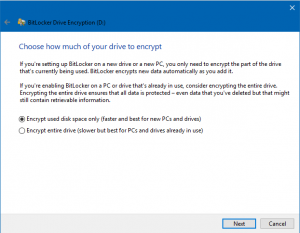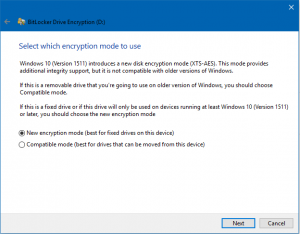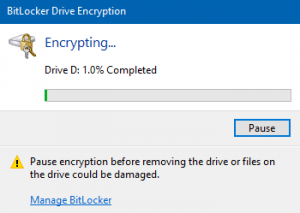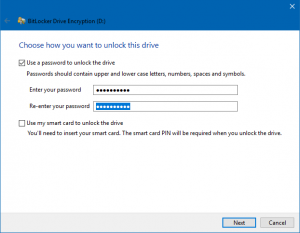BitLocker on Windows
BitLocker will encrypt your USB drive and then require a password to be entered whenever it is connected to a PC. To get started using BitLocker, connect your USB drive to your computer. Right-click on the drive and click on Turn on BitLocker.
It will take a moment to initialise the drive
Next, you will need to pick how you want to unlock the drive. You can choose to use a password, use a smart card or use both. Most users the password will be the best option.

Click next, you’ll need to choose how you want to save the recovery key in case the password is forgotten. It is very important to save this somewhere you will be able to find it later because if you forget the password the drive contents will be inaccessible without this.
You can save to a file or print the recovery key. It may give other options on personal computers, but you will not be permitted to save the key on another encrypted drive. For most users a network location would be best. Printing can be done too, and it can be useful to print to a PDF file which you can save anywhere.

When you click next, you need to choose how much of the drive you want to encrypt. If the drive has never had any business content, then encrypting used space is fine, if unsure or the drive has been used and data deleted then make sure you encrypt the whole drive. Deleted files are still recoverable, so you will want to ensure all those areas are also encrypted.

Click next and you will be asked to choose the version of encryption to use. Both offer the same protection, but the newer version will work only with windows 10. If you will need to use the drive on older versions of windows then choose compatible and click next.

When you then click Next you will be informed that the drive is ready, and you have a last opportunity to back out. If you do cancel remember that the codes, you generated and saved earlier will be useless if you start again later.
Clicking Start Encrypting will begin to encrypt the drive. The time will depend on how big your drive is and how much data needs to be encrypted.

Now if you go to another Windows 10 machine and plug in the drive, you’ll see a little message appear in the notification area. In earlier versions of Windows, just go to Explorer.

